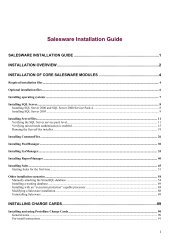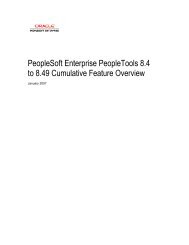Cognos ReportNetTM Installation and Configuration Guide
Cognos ReportNetTM Installation and Configuration Guide
Cognos ReportNetTM Installation and Configuration Guide
You also want an ePaper? Increase the reach of your titles
YUMPU automatically turns print PDFs into web optimized ePapers that Google loves.
Chapter 4: Configuring ReportNet<br />
5. Under the Certificate Authority settings property group, set the Password property to<br />
correspond to the one configured on the Content Manager computer.<br />
6. Ensure that all other cryptographic settings correspond to the ones you set on the Content<br />
Manager computer.<br />
7. From the File menu, click Save.<br />
After you completed the required configuration tasks for each gateway computer in your<br />
environment, you can continue to configure the gateway computers by changing the default<br />
property settings so that they better suit your environment. For example, you can configure a<br />
gateway to use a namespace.<br />
Finishing the <strong>Configuration</strong> of Distributed <strong>Installation</strong>s<br />
After you complete the required configuration tasks, you can perform some additional<br />
configuration tasks to customize the behavior of ReportNet to better suit your reporting<br />
environment (p. 40).<br />
Ensure that you configured the Content Manager computer before you change default<br />
configuration settings on other ReportNet computers.<br />
• For distributed installations, we recommend that you specify the amount of resources the<br />
ReportNet service uses to ensure performance is optimized.<br />
If you are satisfied with your configuration, you can now install <strong>and</strong> configure Framework<br />
Manager.<br />
Changing Default <strong>Configuration</strong> Settings<br />
When you install ReportNet components, the installation uses default configuration settings. If<br />
you have any reason not to use these default values, such as a port is being used by another<br />
process, use <strong>Cognos</strong> <strong>Configuration</strong> to change the value.<br />
If you change the value of a property, you must save the configuration <strong>and</strong> then restart the<br />
ReportNet service to apply the new settings to your computer.<br />
You can also change the default behavior of ReportNet. For example you can<br />
• change a port number<br />
• use an authentication provider<br />
• configure cryptographic settings<br />
• configure SSL protocol<br />
• configure temporary file properties<br />
• specify where to send log messages<br />
• configure ReportNet to use alternate gateways<br />
• configure the gateway to use a namespace<br />
• enable <strong>and</strong> disable services<br />
• specify the amount of resources the ReportNet service uses<br />
• change global settings, such as product <strong>and</strong> content locales<br />
• configure fonts<br />
• change the default font for reports<br />
• configure <strong>Cognos</strong> Portal Services<br />
After you change the default behavior of ReportNet to better suit your reporting environment,<br />
you can test the installation <strong>and</strong> configuration or install <strong>and</strong> configure Framework Manager.<br />
Change a Port Number<br />
If you have any reason not to use a default port, such as it is used by another process, you can<br />
change it.<br />
40 <strong>Cognos</strong> ReportNet TM
















